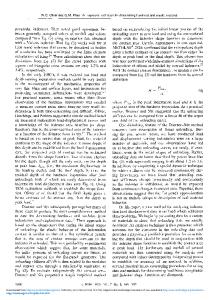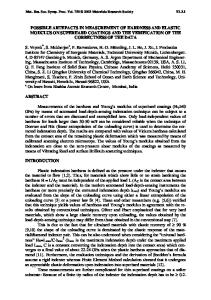Measurement of hardness and elastic modulus by instrumented indentation: Advances in understanding and refinements to me
- PDF / 677,958 Bytes
- 18 Pages / 612 x 792 pts (letter) Page_size
- 35 Downloads / 379 Views
Measurement of hardness and elastic modulus by instrumented indentation: Advances in understanding and refinements to methodology W.C. Oliver MTS Systems Corporation, Oak Ridge, Tennessee, 37830
G.M. Pharra) The University of Tennessee and Oak Ridge National Laboratory, Department of Materials Science and Engineering, Knoxville, Tennessee 37996 (Received 15 June 2003; accepted 23 September 2003)
The method we introduced in 1992 for measuring hardness and elastic modulus by instrumented indentation techniques has widely been adopted and used in the characterization of small-scale mechanical behavior. Since its original development, the method has undergone numerous refinements and changes brought about by improvements to testing equipment and techniques as well as from advances in our understanding of the mechanics of elastic–plastic contact. Here, we review our current understanding of the mechanics governing elastic–plastic indentation as they pertain to load and depth-sensing indentation testing of monolithic materials and provide an update of how we now implement the method to make the most accurate mechanical property measurements. The limitations of the method are also discussed.
I. INTRODUCTION
The method we introduced in 1992 for measuring hardness and elastic modulus by instrumented indentation techniques has widely been adopted and used in the characterization of mechanical behavior of materials at small scales.1,2 Its attractiveness stems largely from the fact that mechanical properties can be determined directly from indentation load and displacement measurements without the need to image the hardness impression. With high-resolution testing equipment, this facilitates the measurement of properties at the micrometer and nanometer scales.3–5 For this reason, the method has become a primary technique for determining the mechanical properties of thin films and small structural features.6–23 Films with characteristic dimensions of the order 1 m are now routinely measured, and with good technique, the method can be used to characterize, at least in a comparative sense, the properties of films as thin as a few nanometers.
a)
This author was an editor of this focus issue during the review and decision stage. For the JMR policy on review and publication of manuscripts authored by editors, please refer to http:// www.mrs.org/publications/jmr/policy.html J. Mater. Res., Vol. 19, No. 1, Jan 2004
During the past decade, we have made several important changes to the method that both improve its accuracy and extend its realm of application. These changes have been developed both through experience in testing a large number of materials and by improvements to testing equipment and techniques. For example, the measurement of contact stiffness by dynamic techniques allows for continuous measurement of properties as a function of depth and also facilitates more accurate identification of the point of first surface contact.24 We have also developed improved methods for calibrating indenter area functions and load f
Data Loading...










